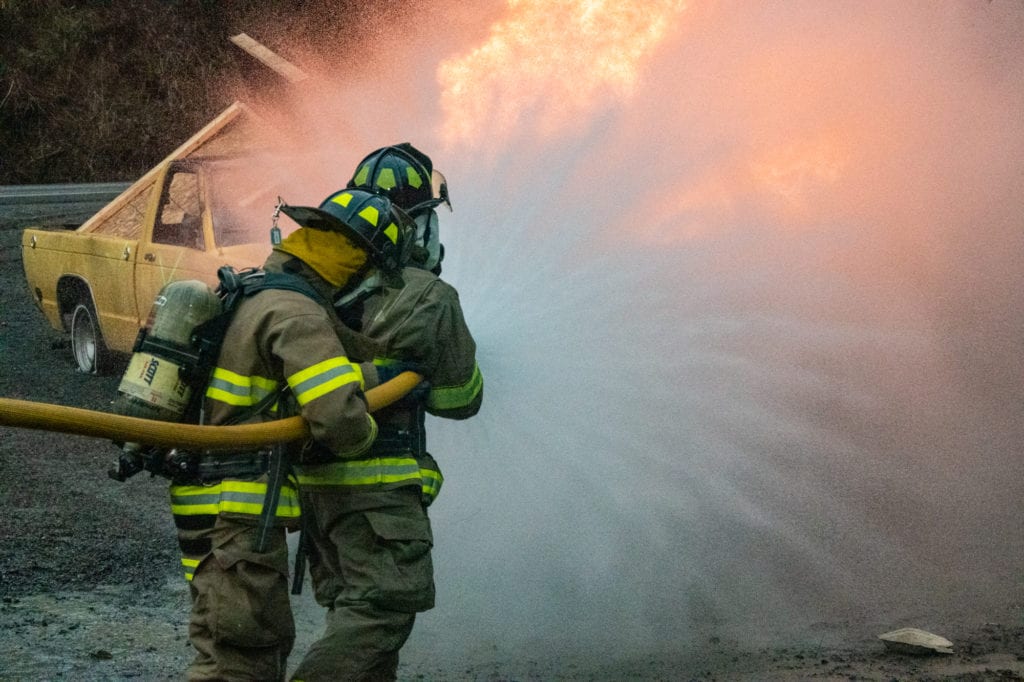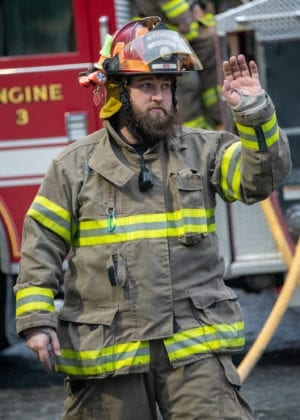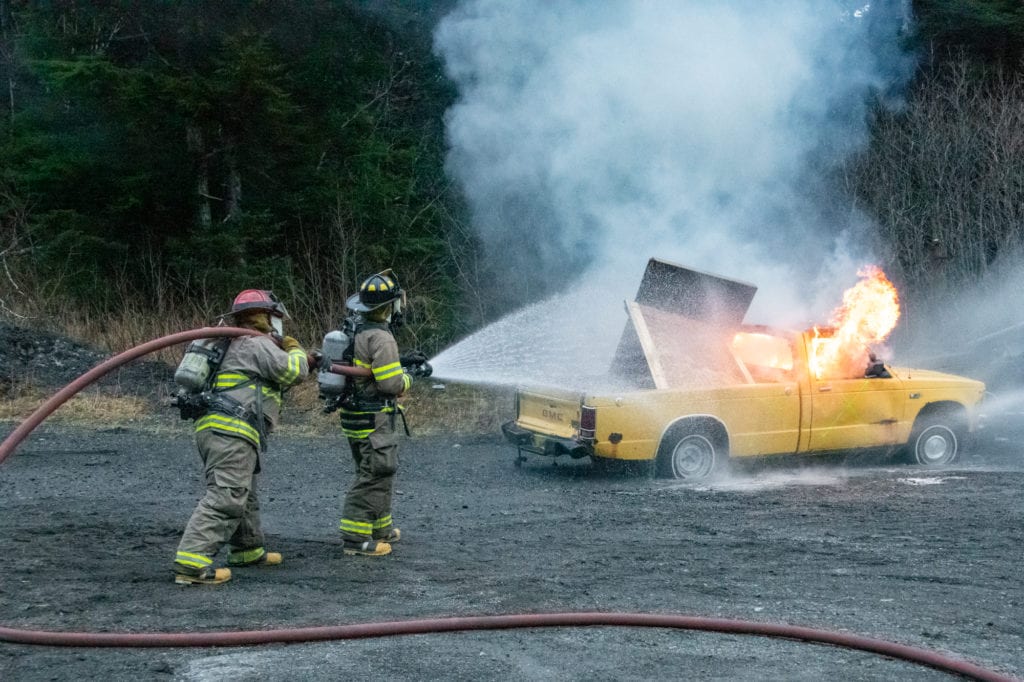
Final exams are always tough — but when was the last time a teacher asked you to extinguish a burning truck, or to navigate an obstacle course blindfolded?
Cordova Volunteer Fire Department members undergoing a 280-hour class are required to master everything from fire science and building construction to knot-tying and department history. Saturday, Jan. 16, students went on a field trip to a site off the Copper River Highway where they trained their hoses on a pair of burning pickup trucks. The donated vehicles were set alight by Fire Marshal Paul Trumblee using “Trumblee’s special blend,” a potent accelerant whose formula is a department secret.
“Fire is fun!” firefighter Chris Iannazzone remarked. “Seeing a fire and putting it out really gets the adrenaline going… There’s a lot more to this training than I would have ever imagined.”
The department’s close-knit teamwork helped turn a potentially trying ordeal into a fun and challenging afternoon learning to wield high-pressure hoses, said firefighter Jayleene Garrett.
“I can read textbooks all I want, but real life is completely different,” Garrett said.
The course, which commenced Nov. 2, is scheduled to conclude Feb. 20, after which graduates will receive Firefighter 1 certification. Alaska’s first Firefighter 1 curriculum was designed in Cordova in 1975.
In a community where fires are rare, exercises involving real fire are vital for keeping skills sharp, said Fire Chief Mike Hicks. The CVFD responded to only 17 fire calls in 2020, false alarms included. This compares to an estimated average of 60 fire calls per year during previous years, Hicks said.
“We do a lot of training for a very few events,” Hicks said.

The Jan. 16 vehicle fire exercise also taught students the importance of careful water management, Fire Marshal Paul Trumblee said. In an area with limited fire hydrant coverage, efficient water usage can be critical. A fire truck’s water tank may look inexhaustible, but a pair of hoses running at full blast can drain it in two minutes, Trumblee said.
As well as the obvious danger of exploding gas tanks, students also familiarized themselves with the risks posed by other potentially volatile car components: shock absorbers that can combust and launch a car’s bumper like a missile, and airbags that can trigger unexpectedly. As a safety precaution, these elements are de-energized before controlled vehicle burns, CVFD officials said. Students also learned to read smoke, which may change color depending on the state of the fire.
Ironically, hours after training wrapped up, the department responded to a call reporting a chimney fire on a wood-burning stove. Such fires can occur when chimneys aren’t regularly cleaned or when stoves are used to burn wood that is not sufficiently dry and seasoned.
Live fire exercises, though dramatic, are not necessarily the most grueling parts of firefighter training: Iannazzone said that the department’s blind obstacle courses were among the toughest parts of the class. In some exercises, a student puts their uniform hood on backward and crawls through a fire hall strewn with props that threaten to trip them up or snag on their equipment. This helps students learn to disentangle themselves from wiring and other building debris without being overcome by panic or frustration.
“It’s great fun to watch, but it’s not a lot of fun when you’re doing it!” Hicks said.
Students also train in rescue scenarios during which one firefighter must drag another to safety, or share their oxygen supply. While larger communities may fire academies with dedicated training areas, Cordova must find inventive ways to expose firefighters to the stresses of the job before they’re forced to confront them in the real world.
“If they’re going to have issues with claustrophobia or issues with their gear, we want them to have those issues in a controlled environment,” Hicks said.

Another particular challenge for students is learning to don the firefighter’s protective gear and breathing apparatus in less than one minute apiece. Garrett initially required more than six minutes to get suited up, but, after practicing “a million times,” she’s well under the minute mark, she said.
CVFD holds regular training sessions at the Cordova Fire Hall at 7:30 p.m. on Thursdays. Anyone interested in volunteering with the department is welcome to attend, Trumblee said.
“Having properly trained firefighters is important, especially in a volunteer organization,” Hicks said. “In Anchorage, they have a full-blown academy, just like a police academy. We don’t have that luxury here, but we have some really good-quality folks… If things start going bad, you have to be able to trust the person that’s alongside you to back you up, because your life is in their hands, and vice versa.”














